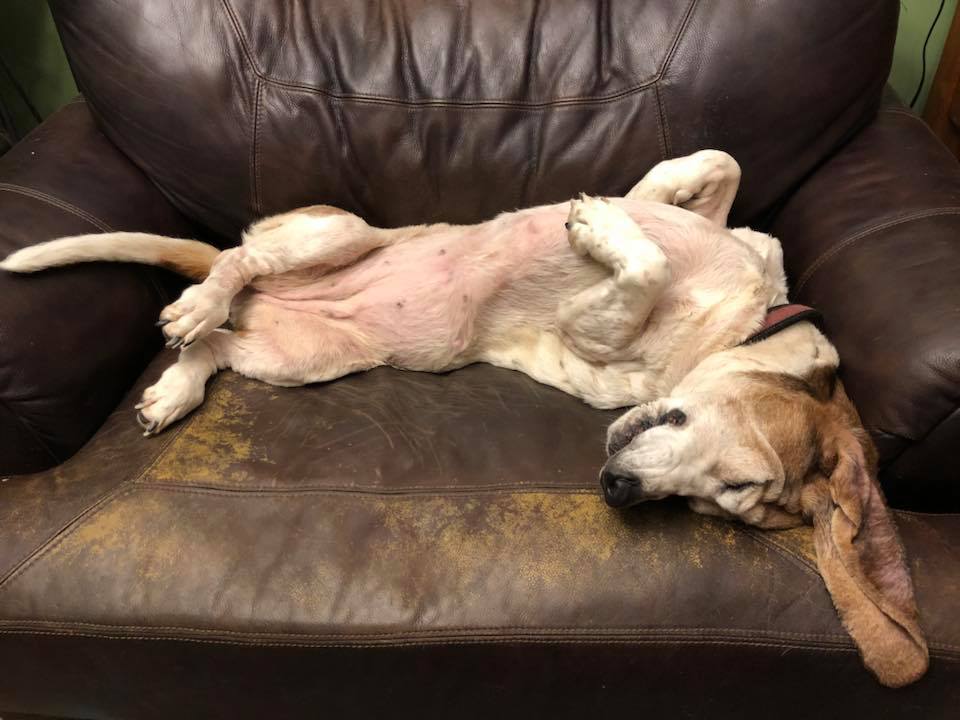Horses, Hounds, and Hyperflexibility: Just Another Day on the Farm

Flash, the offending hound, on another day. (Photo by Karen Del Vecchio)
When you live on a farm, you are witness to many bizarre events. Animals are amazing and wonderful, but they have their moments and a baffling knack for getting into unusual situations. I have an apartment on a 17-acre horse farm that also has pigs, ducks, chickens, dogs, cats, and a peacock named Petey. They all seem to derive entertainment by waiting to cause trouble when I’m the only one around. This weekend, when the farm’s owner was out of town, was no exception.
After taking care of morning chores, I was feeling surprisingly good, all things considered (I’ve been dealing with a pain flare recently), when I realized that Flash, a 16-year-old (ish) rescued basset hound was missing. Her disappearance is not usually a big deal, but she’s been having more trouble with her eyesight lately, and I was worried that she’d wandered off and gotten stuck somewhere. I had searched all over for the better part of an hour when my neighbor suggested looking under the shed. He’d seen her crawl out from under there last week. Sure enough, there was Flash, passed out cold under the shed. I wish I’d taken a picture.
No amount of bribery could convince her to come out — no kibble or bones — and no poking or prodding her gently with a long stick. She appeared to be stuck, she thought that she was, or she was feeling particularly stubborn. I tried everything in my over-flexible library to contort my body to reach her. I mean, when the opportunity arises, sometimes you have to use your “issues” as a superpower, even if you pay for it later. I twisted myself so that I could touch her tail and give it a wiggle, but I couldn’t reach in far enough to grab hold of her.
Unfortunately, no amount of hyperflexible superpowering was going to allow me to lie down between the shed and the wall behind it. Sadly, hyperflexibility does not give me the ability to make my broad shoulders smaller. I was running an hour late, Flash was content to stay asleep under there, the day was going to be extremely hot, and I had no idea how I was going to get her out. I admit that some cursing ensued. (Hopefully, the neighbors’ kids were not outside.) Thank goodness for awesome country neighbors.
Two quick calls later and I had one friend on standby and another on the way. At this point, I was soaked in sweat, covered in dirt, and already feeling discomfort in my back and hips from trying to get to Flash. We tried several different strategies unsuccessfully, and then my neighbor, Christina, decided to swap places with me to see if she could lie down where I couldn’t. Thankfully, she is slightly smaller than me so she managed to fit and reach Flash’s hind paw. With some cajoling and wiggling, she finally got hold of her collar and attached a long leash to it. She then tossed it to me. I lay on one side of the shed and gently encouraged Flash to come forward with the leash, while Christina encouraged her from behind.
With some offended howls and annoyed grunts, Flash made it to the edge, almost, and then I put my hyperflexibility to use to reach in and pull her out the rest of the way. It appeared that she had hurt her hips during her shimmy under the shed, which explained why she didn’t want to crawl back out. Arthritis sucks, Flash, I know. I carried her back and got her settled, she drank lots of water, had a cookie and some old dog-joint treats with natural pain relievers, and then promptly passed out on an air conditioner vent. It’s tough being a hound. At this point, all I could do was burst out laughing.
The moral of the story? Sometimes it’s best to find the humor in otherwise not-so-funny situations. And being hyperflexible can come in handy now and then.
***
Note: Ehlers-Danlos News is strictly a news and information website about the disease. It does not provide medical advice, diagnosis, or treatment. This content is not intended to be a substitute for professional medical advice, diagnosis, or treatment. Always seek the advice of your physician or other qualified health provider with any questions you may have regarding a medical condition. Never disregard professional medical advice or delay in seeking it because of something you have read on this website. The opinions expressed in this column are not those of Ehlers-Danlos News or its parent company, BioNews Services, and are intended to spark discussion about issues pertaining to Ehlers-Danlos.







Comments